Notes
Where There's Smoke, There's … Smoke?
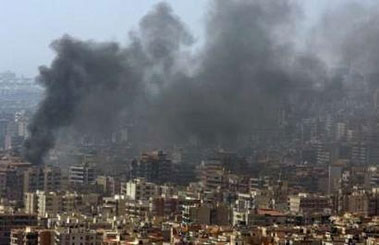
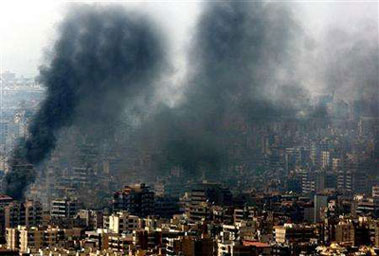
The shot above is Reuters photographer Adnan Hajj’s original photo of an Israeli air strike, taken two days ago. The one below is the photoshopped version that got him canned yesterday. By almost all accounts, Mr. Hajj was caught trying — in the most amateur sort of way — to enhance the smoke in his original picture.
If you follow the links on this story, you’ll see an absolute flood of coverage in the right wing blogosphere. Using Rathergate as its claim to fame, the mob — led by littlegreenfootballs — is assuming that Hajj not only doctored other pics, but possibly also colluded in turning the Qana aftermath into a propaganda show. (If you’re not familiar with this thesis, Richard North’s so-called “investigation” is the post at the center of the Qana conspiracy theory.)
In speculating why Hajj did this, however, the right is actually doing an admirable job confusing the situation with their own propaganda. A much more interesting source of inquiry, I would offer, comes from a discussion among a group of professional photographers that was in full swing on Sportshooter just as the story broke.
If there are points of agreement between the photographers and the wingnuts (including the belief that Hajj’s excuse — that he was simply trying to “eliminate dust” — was ridiculous), the photogs are as amazed as reticent as to why the act occurred. Of course, the right wingers want to believe that Hajj is a Hezbollah sympathizer and, thus, was somehow darkening the photo to make it more foreboding. If that’s true, however, that still doesn’t explain why Hajj would execute this particularly awkward and bone-headed retouch. (Well, the experts and checkers at Reuters who approved the pic might object to the “bone headed” reference, since they were none the wiser until the Rathergate crowd caught it, and flipped out.)
Along those lines, the most telling piece of information that came out of the Sportshooter discussion was the theory that perhaps Hajj wanted to be caught.
As a clinician, I have been taught that you follow the data, no matter where it leads, how weird it seems, or how divergent it is from your best (or favorite) hypothesis. I’ve had a bit of a chance now to look over these shots and check out various other Hajj pics appearing recently in various media. I’ve also taken a little survey of Hajj’s work in the YN thread over the past four weeks. I don’t have a good explanation for the “why” either, but I wonder if the “motive” might be as much psychological as political.
Maybe you’ll think I’m crazy — once you hear this — but it’s possible Hajj might have been obsessed with smoke.
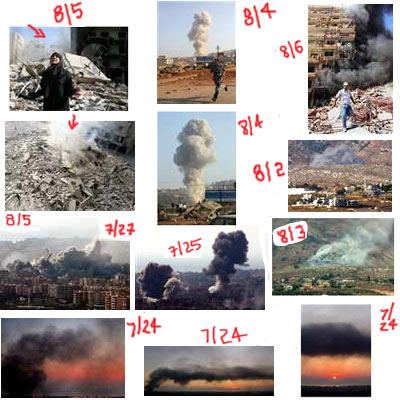
In this montage of his pics over the past two weeks, it’s everywhere. Short of doing an actual statistical analysis, it sure seems like Hajj’s images at YahooNews over the past couple weeks represent a significantly greater percentage of fire/explosion/smoke than do his peers.). What is especially interesting is the series he did — practically a “smoke” study — on July 24th. His caption: Smoke rises from a Hizbollah stronghold in southern Beirut after being hit by Israeli warplanes.
Here are his other captions over that period, with dates. (It’s not a perfect match because not every single caption related specifically to smoke. Almost all do reference it, though.)
Smoke rises from a Hizbollah stronghold in southern Beirut after being hit by Israeli warplanes, July 24, 2006.
A Lebanese Hizbollah supporter kisses a photograph of Hizbollah leader Sayyed Hassan Nasrallah as smoke rises from a building that was targeted by Israeli air strikes in southern Beirut July 24.
Smoke rises from the Hizbollah stronghold in southern Beirut July 25, 2006.
Smoke rises from Arab Saleem area, near Nabatiyeh, in southern Lebanon during an Israeli air raid, August 2, 2006.
Smoke billows as a fire rages following an Israeli strike on Wadi al-Akhdar, near Nabatieh, south Lebanon, August 3, 2006.
Lebanese women walk past the smoking remains of a medical storage depot in Ouzai after it was hit by Israeli air strikes August 4, 2006.
A policeman runs to take cover on the Maameltain bridge, as smoke rises from the Casino Du Liban bridge (background), after they were targeted by Israeli air strikes in the north of Beirut August 4, 2006.
Smoke rises from the Casino Du Liban bridge, as damaged cars are seen on Maameltain bridge, after they were targeted by Israeli air strikes in the north of Beirut August 4, 2006.
Lebanese civilians (top and bottom left) walk past the smoking remains of a flattened building following an overnight Israeli air raid on Beirut’s suburbs August 5, 2006.
And the doctored shot:
Smoke billows from burning buildings destroyed during an overnight Israeli air raid on Beirut’s suburbs August 5, 2006.
So, is Mr. Hajj a Hezbollah sympathizer using subterfuge to maximize and enhance the perception of Israeli aggression? Could he be a slightly shell shocked field photographer who has become a little too fixated on images bearing a specific physical expression of shock-and-awe? Or, could Mr. Hajj have some advancing psychological anomaly expressed by a fetishistic obsession with smoke?
If it’s the latter, by the way, Hajj’s explanation for his actions — that he was simply trying to “eliminate dust” — actually makes some sense.
(image 1: Adnan Hajj/Reuters. August 5, 2006. Beirut. Via YahooNews. image 2: Adnan Hajj/Reuters. August 5, 2006. Beirut. Via YahooNews.)
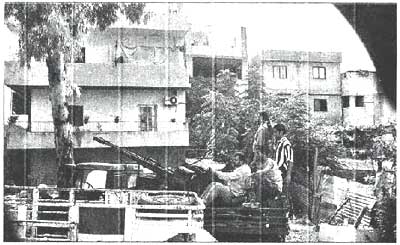
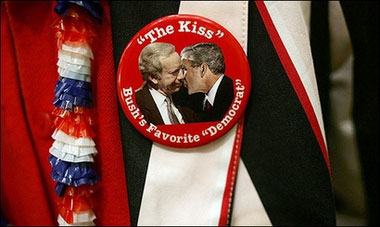
Reactions
Comments Powered by Disqus